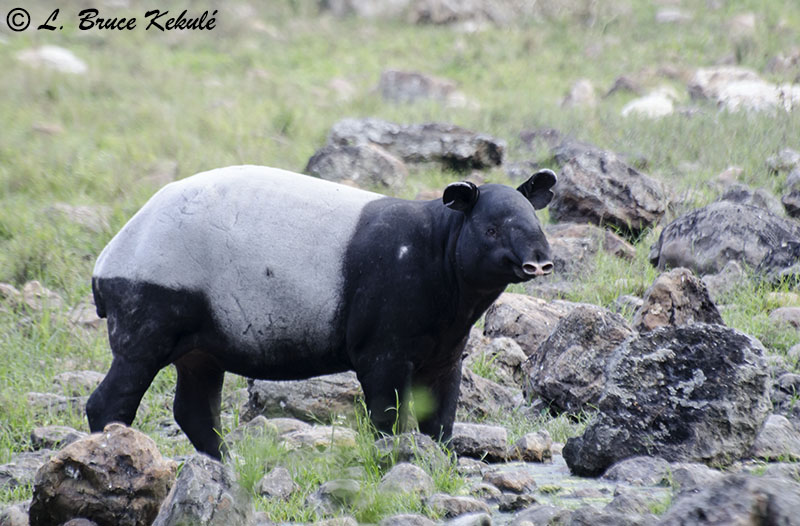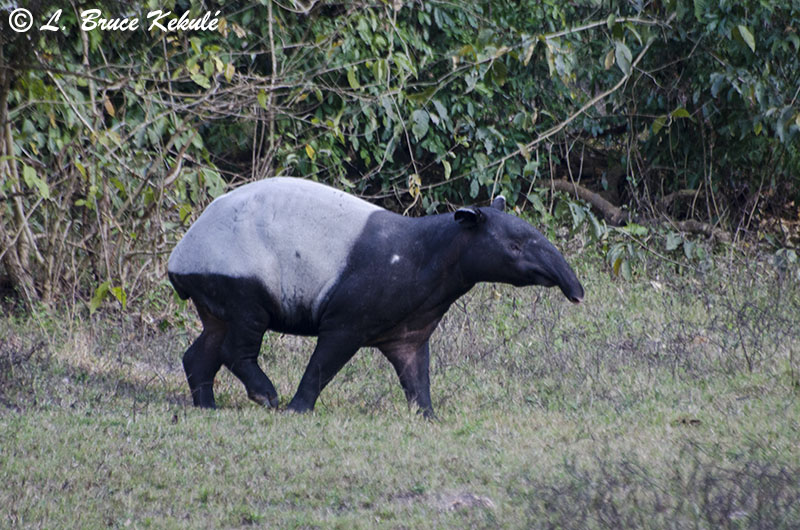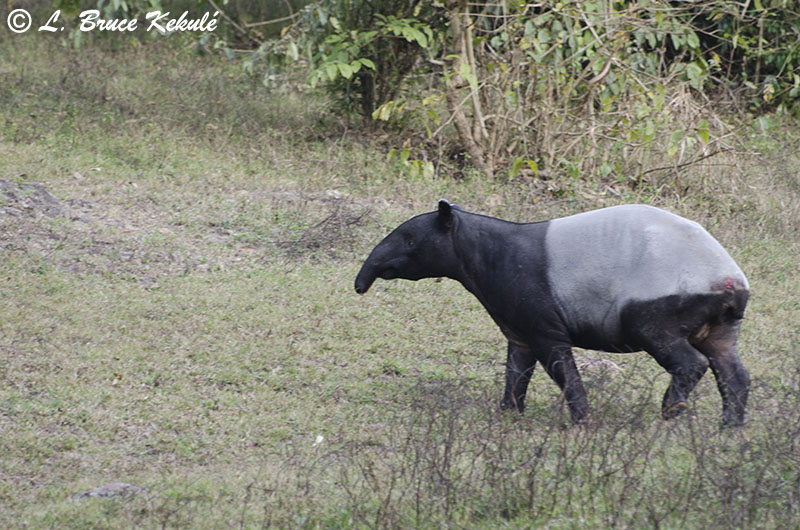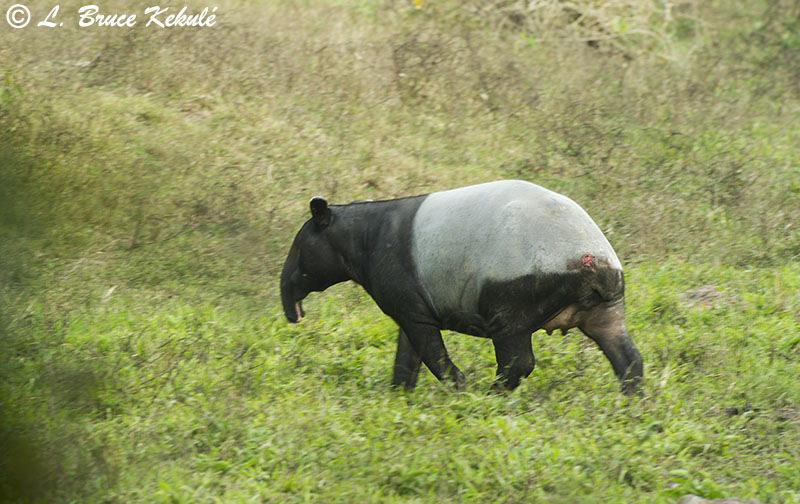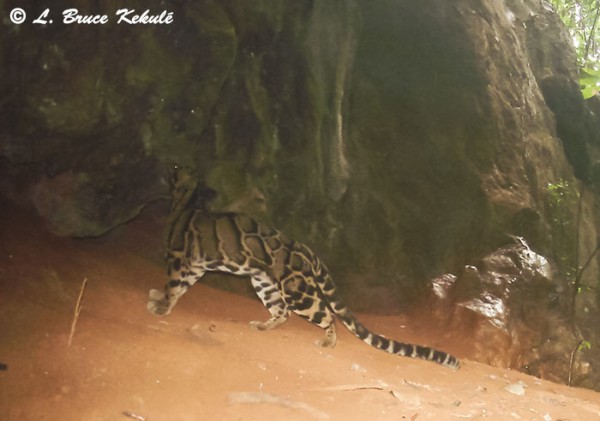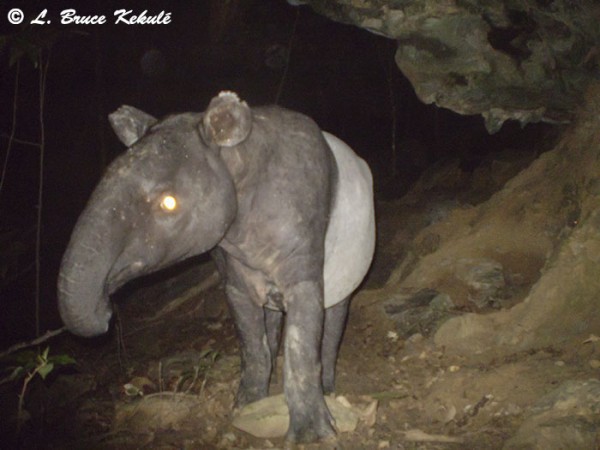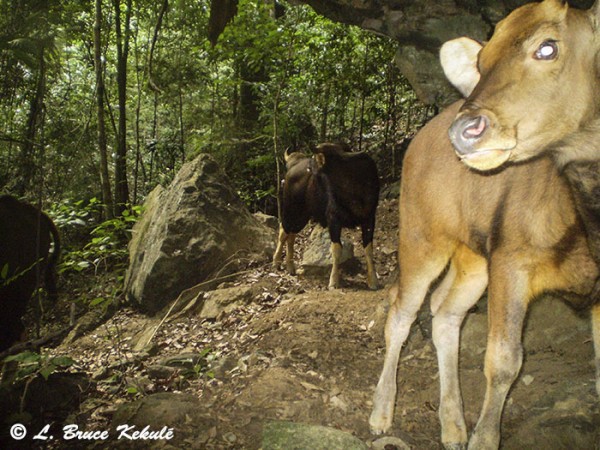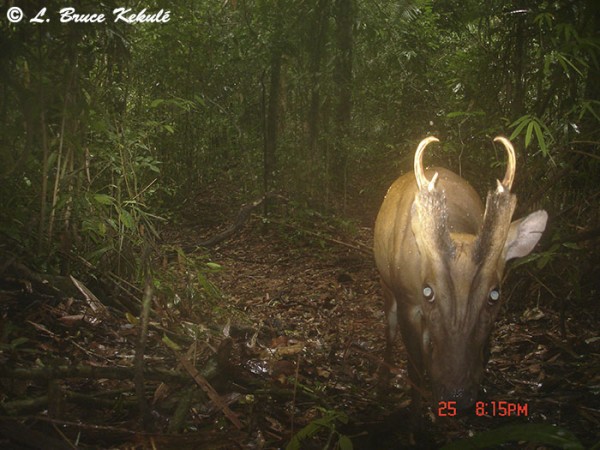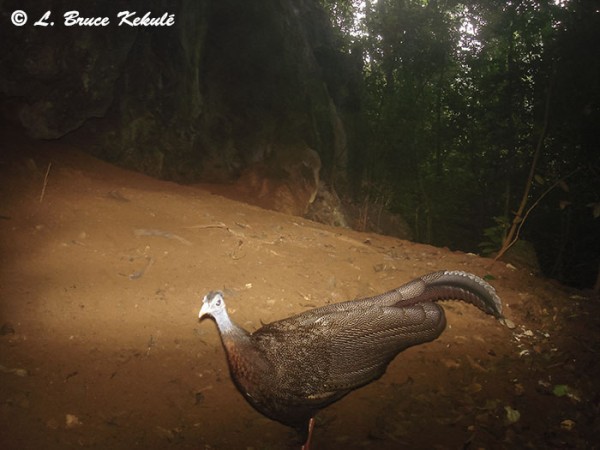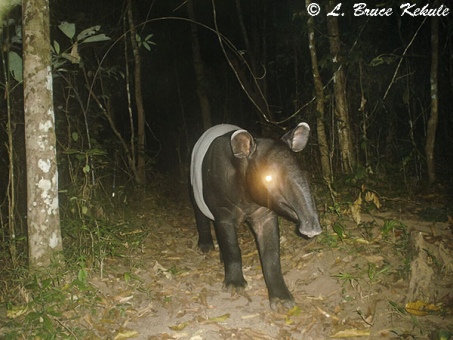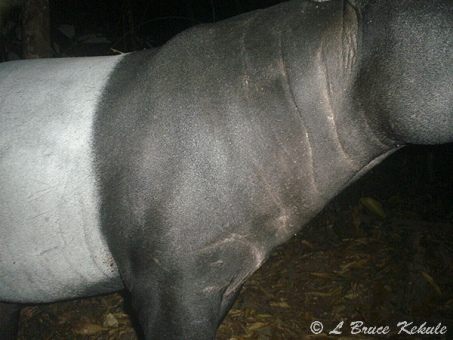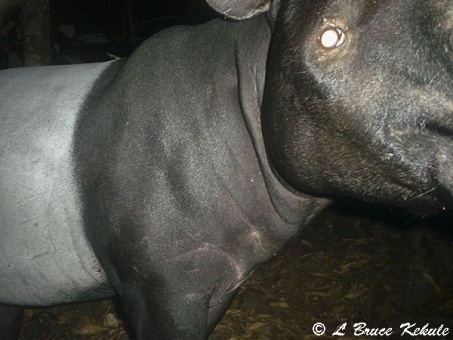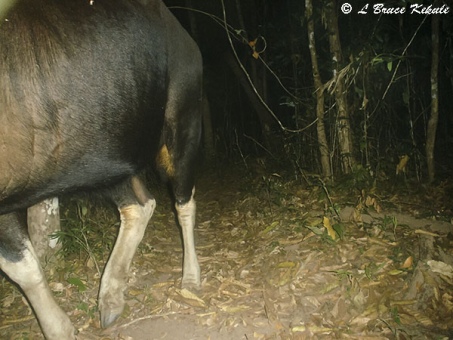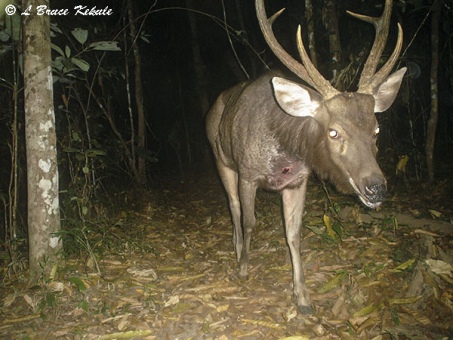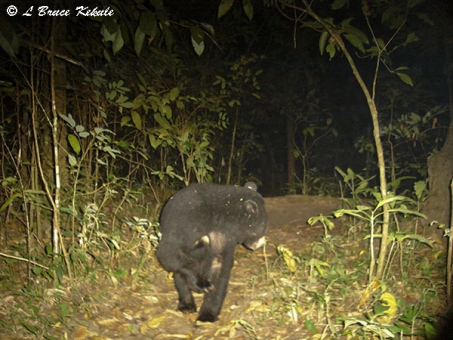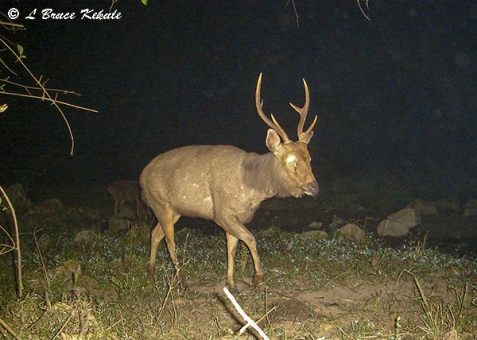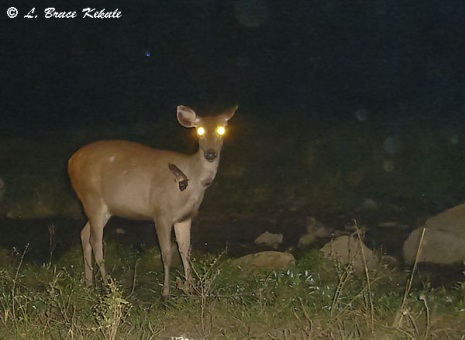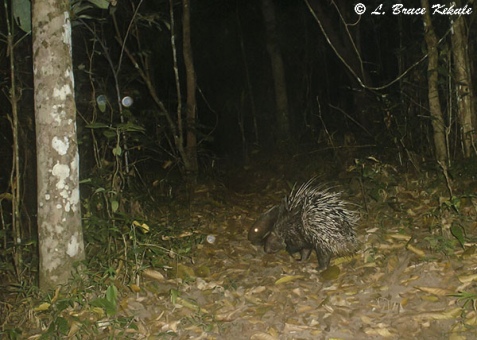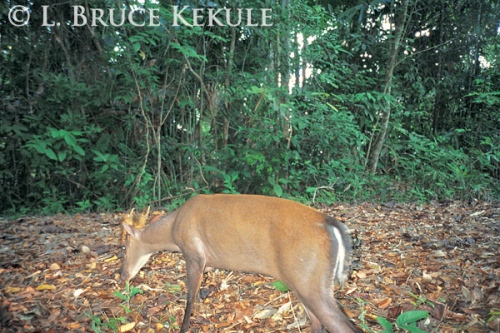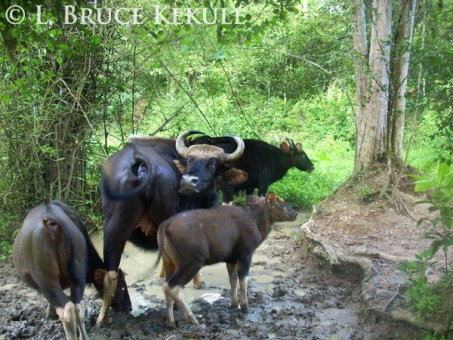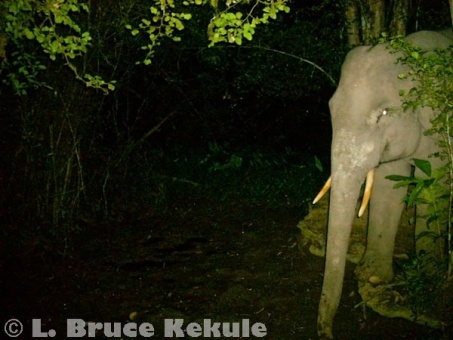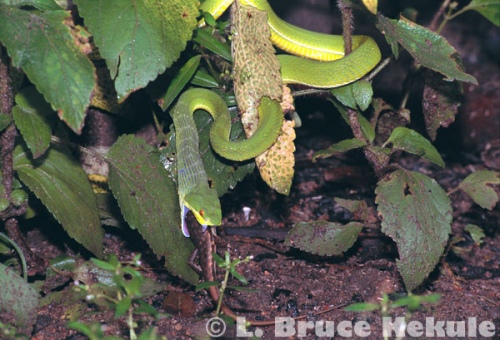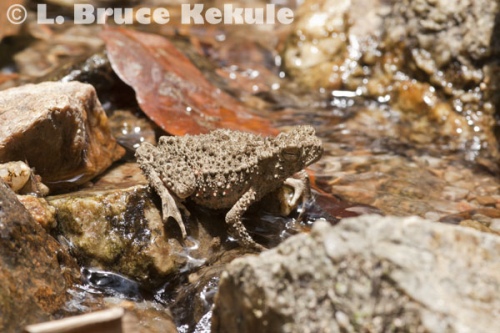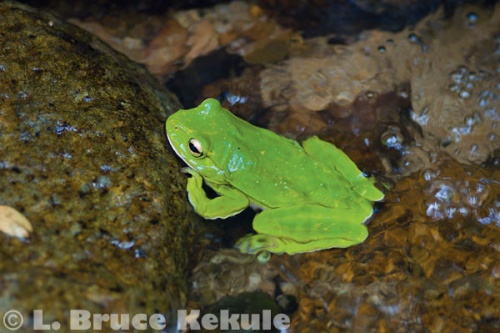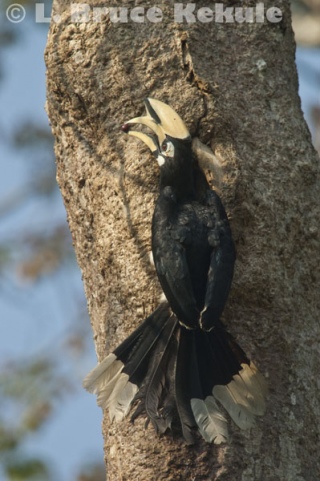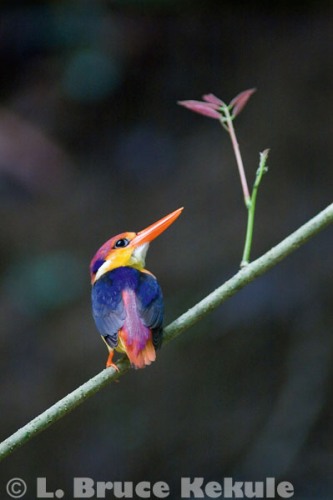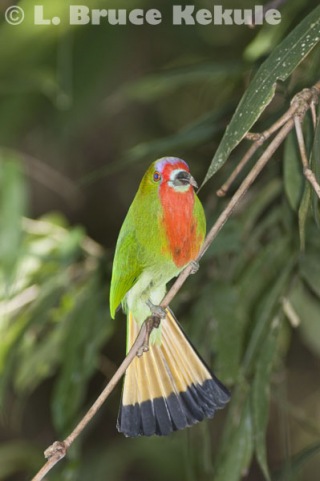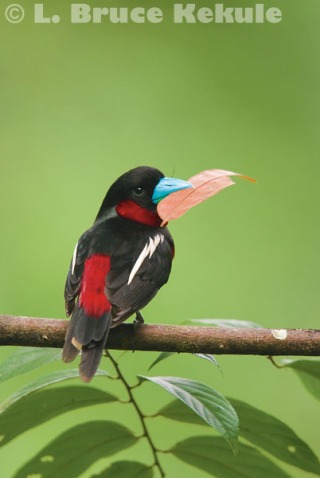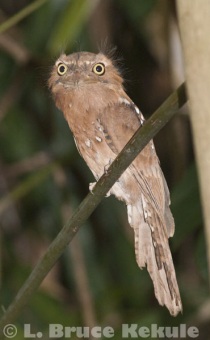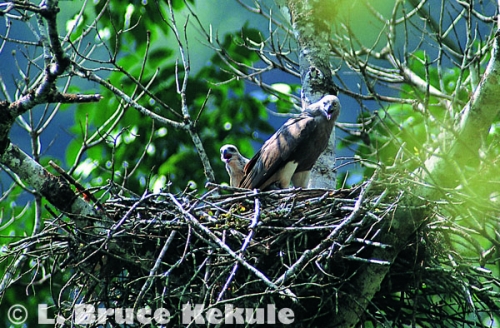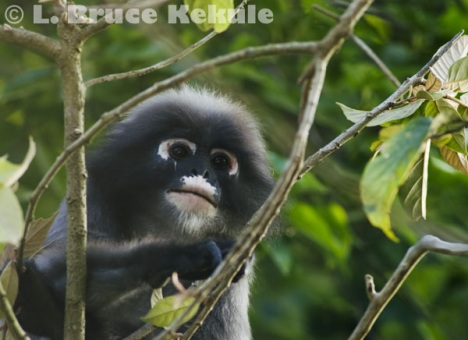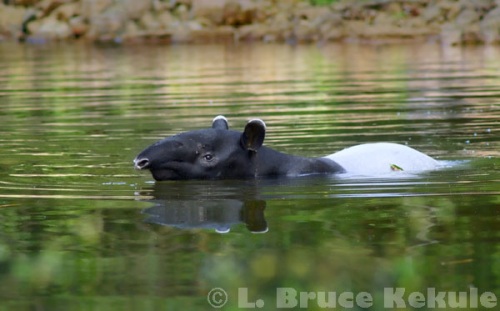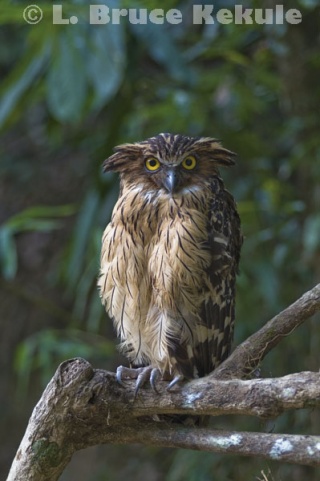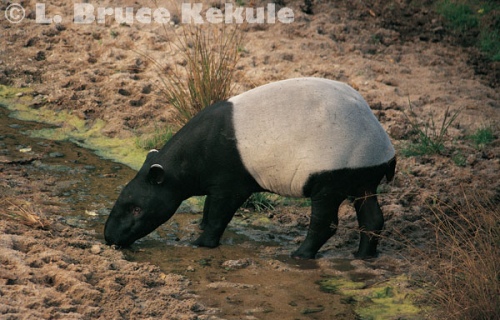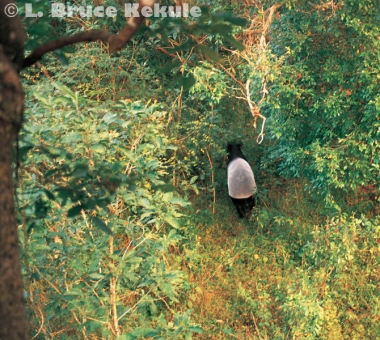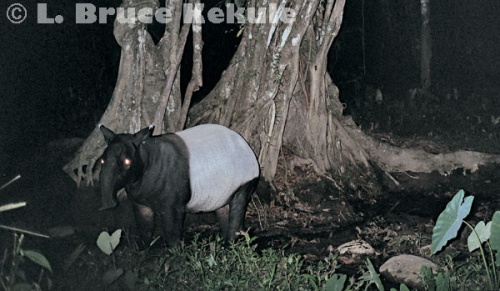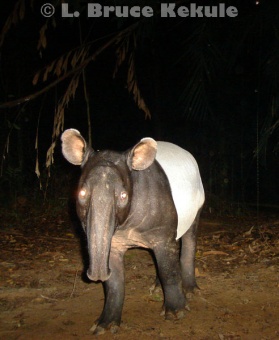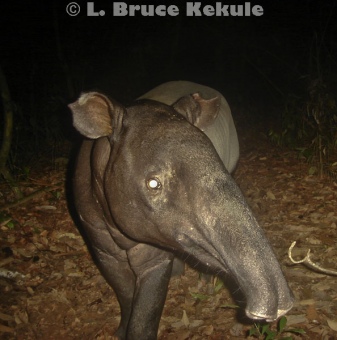Posts Tagged ‘Asian tapir’
Gash – An old Asian Tapir female..!
My Nikon D700 catches an odd-toed ungulate near a hot spring in the ‘Western Forest Complex’
An old Asian tapir female with a gash on her left flank…!
Before my trip to the U.S.A. this year in May, I set a Nikon D700 DSLR trail cam near a hot-spring in the ‘Western Forest Complex’ of Thailand. My first capture was an Indochinese female tiger shown below. But a real bonus was catching an Asian Tapir quite a few times usually leaving the waterhole after drinking the important minerals that seep from a rocky outcrop just down from this location.
Caught again later the same night…does look like she’s been through a meat-grinder…!
The ‘gash’ on it’s left flank is probably caused from a tiger’s claws trying to catch it but not being able to hold on. Tapir have extremely thick hide, and are very agile and fast and can shake-off a tiger. I have seen many tapir with these blood markings. Needless to say, a tribute to the tenacity of this rare species and a lucky catch on my Nikon D700…!
A female tiger camera trapped a few days before the tapir above…!
When it rains tapir, it pours tapir…!
A rare late afternoon capture of an Asian tapir Tapris indicus
A female tapir at a mineral hot spring in the Western Forest Complex of Thailand…!
Recently (Nov. 2014), I caught a female tapir that looked pregnant on my Canon 400D trail cam down in Southern Thailand at Khlong Saeng Wildlife Sanctuary located in Surat Thani province far off the beaten track.
First shot coming down the hill …!
The site is 60 kilometers by boat into the protected area. I got some really nice shots of the odd-toed ungulate as it moved along a wildlife trail on a ridgeline down to the reservoir. Also got a beautiful clouded leopard even though it was a bit out of frame. I counted my lucky stars…!
I have named this old girl ‘White Spot’ seen on her right shoulder…!
Then, I went back to Bangkok for some rest and after a few days, decided to go into my favorite protected area in the ‘Western Forest Complex’ to check and set-up a couple trail cams, and to sit in a photo blind where I got a black leopard 16 years ago, and then again in 2013.
What a pose with her rear leg extended just like a pedigree dog…!
I recently missed a black cat here when my Nikon 400 ƒ2.8 lens went on the blink in November last year. In 2010, I camera trapped a tapir in the morning just down from the blind. It has been a marvelous place and I have caught many species of Asian wildlife through the lens and by camera trap that come to the hot spring.
She must have heard me rustling in the leaves…!
As I was setting up my Canon 400D trail cam below the photo-blind, I got a bit frustrated as the camera would not trip after setup and so I left it. I was only 15 meters away from the blind. Somehow, I had nudged the control button to ‘Auto’ as I was to find out the next day.
And she high-tailed back up the hill but stopped short and came back down…!
I got five-steps, and there stood a female tapir out in the open coming down the hill to the hot spring. As I always carry a Nikon D7000 and a 70-300mm VR lens, I immediately started shooting.
Making her way back down to the mineral hot spring…!
I was also out in the open but as she looked the other way, I moved a little bit closer to get to my big lens (Nikon D3s and 200-400mm VR II) sitting on a tripod ready for action.
Still has not seen me…!
Tapir have very poor eyesight but hearing and smell are good. She must have heard me as she bolted back up the hill. She stopped short and then came back down. I was still shooting with the D7000. I finally got into the blind and started shooting the big camera. It was very exciting to see this odd-toed ungulate as they are nocturnal for the most part and hardly ever seen in the day.
A female for sure and a large wound on her rump: maybe a tiger or leopard, or wild dogs…!
I know of someone who has spent many years trying to photograph this species with no luck. He once spent 10 days at this hide unsuccessfully and then at another location for eight days. He left the sanctuary in despair and has been chasing them ever since..!
The moral of this story: Have a camera over your shoulder at all times if you are in the forest working or traveling through. You never know when something might pop out…I learned this from a National Geographic staff photographer (William ‘Bill’ Albert Allard) when he was here in Thailand as we chased down domestic elephants for a story in N.G. magazine…!
He said: “if you don’t have a camera, you aren’t going to get a shot”. It was a neat job and the pay was great. But it was the knowledge and ‘tricks-of-the-trade’ I picked up from him that has really paid off over the years. I think he took a shower with a camera around his neck..! Needless to say, I always have one ready just in case. I might have missed this tapir if I had left it up in the blind…! Enjoy
Canon 400D catches an old Asian tapir and clouded leopard
Southern Thailand’s natural heritage – an odd-toed ungulate and a carnivore
A mature Asian tapir caught by a Canon 400D trail cam…!
Just returned from Khlong Saeng Wildlife Sanctuary in the south of Thailand and pulled my Canon 400D camera trap. These shots are of an old Asian Tapir and the best ones in this set as shown here. Being odd-toed ungulates and strictly vegetarian, these large herbivorous mammals thrive quite well in this unique ecosystem made up of moist evergreen forest. These unique creatures have been on the planet for about 40 million years. They are the largest of the world’s four species with the other three in South America…!
This tapir almost looks pregnant…!
A clouded leopard in daylight…!
This cam also caught a clouded leopard but the cat came in a bit low. These cats are not normally out in broad daylight but I guess they do sometimes prowl during the day. That was the trade off for the full-frame tapir shot. This sanctuary is simply amazing and I look forward to future visits…! Enjoy…!
Living Fossils – A video of Asian tapir
Rare daytime footage of Asian Tapir
Tapir are considered living fossils as the genus has been traced back as far as Early Oligocene times. These remarkable mammals have been on the planet for about 40 million years. The first tapirs are named Miotapirus judging from fossil evidence found in North America. Tapiridae, a sub-family belong to the Order Perissodactyls, or odd-toed ungulates that goes back to the Late Paleocene 55 million years ago including rhinoceros-like creatures evolving in North America and eastern Asia from small animals similar to the first horses.
The Asian tapir Tapirus indicus, also called the Malayan tapir, is the only one native to Southeast Asia. It has an unmistakable black and white two-tone pattern distinguishing it from the other three tapir species of Central and South America. The Asian species is the largest, and is the only ‘Old World’ tapir with the females usually slightly larger than the males. They live in the rainforests of Thailand, Myanmar, Malaysia and Sumatra.
This old male and female tapir visited this site more than once over two days. Most of the footage was captured by a Bushnell HD Trophy Cam, and the IR clip by a Ron Davis DXG 125v IR homebrew cam.
Chasing a Wild Dream
A video about Thailand’s Amazing Wildlife in the Western Forest Complex. From wild elephants to green peafowl, this film shows the world the wildlife in the Kingdom’s protected areas, and the need to save this wonderful natural heritage for present and future generations to come.
In the heart of Southeast Asia, the Kingdom is blessed with some of the best and last remaining examples of Asian animals and ecosystems that harbor the tiger, leopard, elephant, gaur, banteng, wild water buffalo, tapir, sambar, muntjac, gibbon, green peafowl, hornbill, plus thousands of other amazing creatures and biospheres that have evolved over millions of years and show-case Mother Nature and her magnificent beauty…!
Keang Krachan: Rare creatures surviving in the park
A collection of photographs taken from 2001 to 2008
of some rare Asian animals still thriving in this amazing forest
Fea’s muntjac camera-trapped at Kilometer 33 on Phanern Thung mountain
Male muntjac also known as common barking deer at a mineral lick
Male muntjac feeding on leaves
Gaur cow at a mineral lick in the interior
Small gaur herd at another mineral lick
Gaur bull and cow footprint compared to my hand
Asian tapir swimming in the Phetchaburi River
Tapir camera-trapped near the Phetchaburi River
Serow camera-trapped on old logging road
Tusker camera-trapped at a mineral deposit at kilometre 12
Tuskless bull elephant in ‘musth’ camera-trapped on an old logging road
Tiger camera-trapped at a mineral lick in the interior
Indochinese tiger camera-trapped by the Phetchaburi River
Asian leopard camera-trapped on a nature trail
Indian civet caught near Ban Krang campground in the park
Banded linsang camera-trapped on a dry streambed
Banded palm civet camera-trapped by a stream deep in the interior
A king cobra hunting for prey by the Phetchaburi River
A green pit-viper and carpenter ant on a small tree
A green pit-viper swallowing a skink
Reticulated python on the road in Kaeng Krachan
Horny tree frog in a stream deep in the park
Giant tree frog further upstream
Great hornbill flying out of a fruit tree
Oriental Pied hornbill feeding its chicks at the nest
Wreathed hornbill at a nest
Oriental dwarf kingfisher near it nest
Pied kingfishers with a fish on a tree branch
Blue-bearded bee-eater with a beetle for its chicks
Red-bearded bee-eater close to its nest in a sandbank
Black-and-red broadbill with a bamboo leaf
Black-and-red broadbill building a nest
Javan Frogmouth by the Phetchaburi River
Lesser fish-eagle chick exercising its wings high up a very tall tree
Lesser fish-eagle mother and chick on the nest above the Phetchaburi River
Lessor fish-eagle on a tree branch behind my blind over the Phetchaburi River
River carp in the Phetchaburi River
Gibbon hanging from a bamboo on Phanern Thung mountaintop
Dusky langur near the Phanern Thung ranger station
Stumped-tailed macaque by the river
Rainbow over the Phetchaburi River
Kaeng Krachan National Park is an amazing place but is fraught with poor management and protection. There are many other animals and ecosystems not shown here but this place is truly one of Thailand’s greatest protected areas.
It takes lots of hard work to get down to the river and collect photographs of the creatures thriving there. But diligence, determination, the right equipment, money and with good guides, is also within the reach of serious amateur photographers or naturalists who just want to look.
The opportunities are endless. It is hoped these photographs will create awareness and help this place survive into the future, so that generations to come can also enjoy the beauty of nature in Thailand’s largest national park.
My next post will be a collection of photographs from Huai Kha Khaeng like this of that amazing World Heritage Site, and hopefully sometime before I travel to Africa for a safari to Kenya in mid-August.
The Asian Tapir – Living fossil and bizarre mammal
Odd-toed ungulate and strictly vegetarian
The Asian tapir still thrive in Thailand’s dense evergreen forests in the West and South
It was an amazing day in March 2005 near the headwaters of the Phetchaburi River deep in Kaeng Krachan National Park situated along the border with Burma in southwest Thailand. One morning, a buffy fish-owl found stuck in a fishnet was going into shock from hypothermia. I luckily saved this creature from certain death.
Asian tapir posing in the Phetchaburi River
The campfire was going well and I used it to warm up the bird of prey. When it could stand by itself, I placed it on a tree branch and then played wildlife photographer for a short while. I then left the confused animal in peace and it eventually flew across the river and disappeared into the forest. I felt good saving the owl. Under other circumstances, it might not have fared too well.
Buffy fish-owl saved from certain death
Later in the day as we were up-river and just about ready to turn back, a huge king cobra showed-up hunting for prey along the riverbank. I was able to catch a few photographs of the largest venomous snake in the world before it U-turned and disappeared into the forest.
King cobra hunting by the Phetchaburi River
That definitely got the blood flowing as I checked out my shots on my brand new Minolta D7 D-SLR digital camera, the first with anti-shake technology in the camera body. I shot off-hand and was getting some acceptable digital captures. When the smoke cleared, I had only two shots left on the card and decided not to delete any poor exposures as I felt nothing would show after the big snake.
Asian tapir swimming in the Phetchaburi River
It was about 4pm and the light was nice and warm as we headed back to camp more than an hour away. Just then, an Asian tapir bounced out of the forest and dived into the river. It submerged for a short time probably trying to evade a swarm of biting forest flies before surfacing and swimming towards us. I took a shot waiting for the ungulate to get closer. It stopped in the water about twenty meters away.
The tapir has very poor vision and it took a few seconds before the unusual creature saw five humans standing out in the open. Just as I snapped my last shot shown in the lead photo, it swam away and jumped back into the forest it had come from. Seeing one of nature’s remarkable animals, even though briefly, is the ultimate thrill for me.
I know I missed quite a few shots because of old age forgetfulness (not having spare memory cards), but then again, the two shots I captured were more than enough. I was thrilled to capture the world’s largest tapir in broad daylight offhand. If I used a tripod that day, I might have missed it. These creatures are mainly nocturnal and rarely seen during the day. This event was truly the beginning of a new dream and this tapir made the front cover of my third book Wild Rivers. It certainly was special for me, and is etched in memory.
In Thailand, photographing three separate species in one day is surely a rare occurrence as most animals are now tough to see and photograph, especially the tapir. It must have been something about saving the owl earlier in the day and the ‘spirits of the forest’ made up these magical sightings. I will never know. It had been a dream of mine to photograph a tapir in the Phetchaburi River in Kaeng Krachan National Park after seeing a painting in a book produced by the Tourist Authority of Thailand (TAT) about the park.
My first tapir from a tree-blind in Huai Kha Khaeng
Years ago when I made regular trips to Huai Kha Khaeng Wildlife Sanctuary in western Thailand, one visit stands out as a lucky tapir sighting. There is a hot spring deep in the interior that attracts all sorts of large mammals including the tiger, leopard, elephant, gaur, banteng, and the tapir among others. This mineral deposit is part of a complex natural seep several hundred meters long. I was sitting at the bottom-end in a tree blind about eight meters up and waited throughout the day until about 5pm. A few sambar stags came for a drink followed by a doe. A barking deer nervously stepped in but somehow was spooked by something on my right and departed.
My first tapir moving in the forest under the tree-blind
A few minutes later, a black and white creature plowed through the brush and popped out into the clearing. I quickly snapped off a bunch of frames with my Nikon camera and 600mm lens as the tapir took a long drink filling the frame with the large mammal. The tapir then moved under the tree I was in and I managed a couple of shots with a smaller lens as the tapir disappeared into the forest behind me. In those days I was shooting film and was not sure my photos were good until I processed the film back in Bangkok. Shooting black and white mammals is fraught with exposure problems but most of the shots were OK. It was my first lucky sighting of an animal known for its secrecy and nocturnal habits.
Tapir and gaur photographed at a hot-spring in Huai Kha Khaeng
Another memorable tapir sighting was not by me but my close friends, Samak Khodkaew, Amonsak Sirwichai, Sarawut Sawkhamkhet and Ajarn Prapakorn Tarachai. These gentlemen are nature photographers and have helped me in the past with my book projects. I set the four of them up in a permanent photographic blind about noontime at the top-end of the hot spring mentioned above. I then waited for them back at the truck.
Just as darkness arrived, a bull gaur and a tapir arrived almost together. I have never seen a bunch of excited photographers like this group when they finally came out. Two species in one photo is also quite an achievement. I was happy and glad the ‘spirits of the forest’ had smiled on them.
Asian tapir camera trapped in Kaeng Krachan
When I began a photographic and camera-trap program in 2005 along the Phechaburi River in Kaeng Krachan, it was not long before I caught a mature tapir at a mineral deposit late one night. They are thriving there as are other large mammals like tiger, leopard, sun bear, wild dogs, elephant, gaur and sambar.
Asian tapir mother and calf camera trapped in Khlong Saeng
In early 2009, I started a new program in Khlong Saeng Wildlife Sanctuary in Surat Thani province down South. I now have quite a few camera trapped tapir photos where the species is proliferating. The flooded forest of Cheiw Larn reservoir habitat is now unnatural for them but they have adapted to the changed landscape. These amazing herbivores are surviving quite well in the mountains of Khlong Saeng-Khao Sok Forest Complex.
Tapir calf camera trapped in Khlong Saeng
However, tapir numbers have decreased in recent years, and today, like all of the species, is in danger of extinction. Because of their size, tapirs have few natural predators, and even reports of killings by tigers are scarce.
Young ear-bitten tapir camera trapped in Khlong Saeng
The main threat to the Asian tapir is human activity, including hunting for meat, deforestation for agricultural purposes, flooding caused by the damming of rivers for hydroelectric projects, and illegal trade. Protected status in Thailand, which seeks to curb deliberate killing of tapirs but does not address the issue of habitat loss, has had limited effect in reviving or maintaining the population.
In closing, this remarkable wild animal is just another cog in the wheel of Mother Nature’s wonderful array of species adapted to living in the evergreen forests of western and southern Thailand. Their survival depends on one thing: protection and enforcement of the protected areas where they live. Over the long run, it is up to the Ministry of Natural Resources and Environment, and the Department of National Parks to insure that the tapir and all the other beautiful creatures get the best possible safeguards for the future. It is hoped the powers to be will take action to prevent further destruction of the Kingdom’s natural resources.
Tapir up-close
Tapir are considered living fossils as the genus has been traced back as far as Early Oligocene times. These remarkable mammals have been on the planet for about 40 million years. The first tapirs are named Miotapirus judging from fossil evidence found in North America. Tapiridae, a sub-family belong to the Order Perissodactyls, or odd-toed ungulates that goes back to the Late Paleocene 55 million years ago including rhinoceros-like creatures evolving in North America and eastern Asia from small animals similar to the first horses.
The Asian tapir Tapirus indicus, also called the Malayan tapir, is the only one native to Southeast Asia. It has an unmistakable black and white two-tone pattern distinguishing it from the other three tapir species of Central and South America. The Asian species is the largest, and is the only ‘Old World’ tapir with the females slightly larger than the males. They live in the rainforests of Thailand, Myanmar, Malaysia and Sumatra.
The general appearance and characteristics of the Asian tapir is easily identified by its markings, most notably the white “saddle” which extends from its shoulders to its rump. The rest of its hair is black, except for the tips of its ears, which, as with other tapirs, are rimmed with white. This pattern is for camouflage as the disrupted coloration makes it more difficult to recognize it as a tapir at night, or in the dark jungle during the daytime that they prefer. They are mainly nocturnal but do show sometimes in the late afternoon at the river or mineral deposit. Other animals like tiger may mistake it for a large rock rather than a form of prey when it is lying down to sleep.
The Asian tapir grow to between 1.8 to 2.4 m in length, stand 90 to 107 cm tall, and typically weigh 250 to 320 kg, although they can weigh up to 500 kg. The females are usually larger than the males. Like the other types of tapir, they have small stubby tails and long, flexible proboscises. They have four toes on each front foot and three toes on the back feet.
The tapir has very poor eyesight, and making them rely greatly on their excellent sense of smell and hearing to go about their everyday lives. The tapir has small, beady eyes with brown irises on either side of their face. Their eyes are often covered in a blue haze, which is corneal cloudiness thought to be caused by repetitive exposure to light. Corneal cloudiness is when the cornea starts to lose its transparency.
The gestation period of the Asian Tapir is approximately 390-395 days, after which a single offspring, weighing around 6.8 kg, is born. Young tapirs of all species have brown hair with white stripes and spots, a pattern that enables them to hide effectively in the dappled light of the forest. This baby coat fades into adult coloration between four and seven months after birth. Weaning occurs between six and eight months of age, at which time the babies are nearly full-grown, and the animals reach sexual maturity around age three. Breeding typically occurs in April to June, and females generally produce one calf every two years. Asian Tapirs can live up to 30 years, both in the wild and in captivity.
Tapir are primarily solitary creatures, marking out large tracts of land as their territory, though these areas usually overlap with those of other individuals. Tapir mark out their territories by spraying urine on plants, and they often follow distinct paths that they have bulldozed through the undergrowth.
Exclusively vegetarian, the animal forages for the tender shoots and leaves of more than one hundred species of plants (around 30 are particularly preferred), moving slowly through the forest and pausing often to eat and note the scents left behind by other tapirs in the area. They tend to eat soon after sunset or before sunrise, and they will often nap in the middle of the night.
However, when threatened or frightened, the tapir can run quickly despite its considerable bulk. They can also defend themselves with their strong jaws and sharp teeth, and have thick hides protecting them from predator attack. They communicate with high-pitched squeaks and whistles. They usually prefer to live near water and often bathe and swim, and they are also able to climb steep slopes.
Photographing three wild species in one day
The beginning of my 3rd book project entitled Wild Rivers
Three species on one lucky day in March of 2005
Like most of my mornings in the forest, getting out of the hammock before dawn is a routine affair for me. Sleeping by the pristine Phetchaburi River in Kaeng Krachan National Park in southwest Thailand is a peaceful and soothing experience with the sound of rushing water flowing down to the lowlands. The night creatures fade into their abodes and daytime is greeted by singing birds and insects. As the sun comes up, gibbons call and hornbills honk from the treetops. It is nature at its very best.
Buffy fish owl by the Phetchaburi River in Kaeng Krachan National Park
I adhere to an old saying; “an early bird get’s the worm” to sometimes work wonders. This was the case one particular morning in March 2005. After a quick cup of coffee, I got my cameras ready for the days’ shoot. I was about to embark on my third book project capturing some extremely lucky wildlife photographs of three different species in one day.
The mighty Phetchaburi River during the dry winter season
About 6am, one of the Karen porters went upstream and found a buffy fish-owl stuck in his fishnets. I was upset at them to say the least but had to think quickly. The bird was going into shock as hypothermia took control over the owl. It was on the verge of dying and only quick thinking saved this creature from certain death. The campfire was going well so I placed the bird close to warm it up and get its blood flowing. I’m sure the creature had no idea what was going on but the bird was calm and collective as I assured it everything would be OK.
Buffy fish owl just after being saved from certain death
The owl began to perk up and I knew then it would survive. I placed it on a tree branch by the river and it locked its talons into the bark. The bird of prey just sat there while I played wildlife photographer. After shooting almost an entire memory card and without further ado, I left the owl in peace.
As I sat down to eat breakfast, it left its temporary perch and flew across the river disappearing into the dense forest. The bird was not seen again. I felt pleased at having saved this beautiful creature’s life. I had just switched to a Minolta digital SLR camera and was able to double-check all my shots for exposure, color and focus. Everything looked good and I was excited at having photographed this owl during the day as they are nocturnal.
King cobra hunting along the Phetchaburi River
After breakfast, we packed up our gear for a day trip headed upriver. In March, the water level is low, and the riverine habitat easy to transverse. The team and I crossed the river several times till about 4pm when I decided to turn back to camp. Just then, my research companion Detchart “Top” Saengsen sighted a large snake and called out. I reached for my camera with a 280mm lens and found a slithering black reptile in the underbrush. Its head appeared and I started shooting, not thinking about the danger. The king cobra – the world’s largest venomous snake – moved into an overhang so I flipped up the flash and took a few more shots. The reptile did a u-turn and was gone in a split second.
The big snake just before it made a u-turn and disappeared in a split second
The rest of the team had already retreated, leaving the crazy photographer to his own devices. It certainly was an exciting experience. I was elated that I had just photographed the true king of the forest. It is said large mammals like elephants, gaur and tigers stay out of the king cobra’s way. I checked my camera and had two shots left on my card. I decided not to delete any poor images until later as I felt nothing would show itself after the big snake.
Asian tapir swimming in the Phetchaburi River
The team and I were in good spirits as we headed back to camp. Suddenly, an Asian tapir bounced out of the thick forest on the opposite bank about a hundred meters away. It dove into the river and started swimming towards us, now fifty meters off. Tapir have fair eyesight but this black and white creature did not notice five humans standing out in the open up on a sandbank. I took one shot of the swimming tapir then waited, knowing very well I only had one frame left. The creature got closer and then stopped in the water about 20 meters away. I centered the focusing ring on the eye and took the shot. Then we watched this elegant animal go back the way it had come.
Asian tapir posing for me in the late afternoon sun
I know I missed quite a few shots because of old age, forgetfulness (not having spare memory cards), but then again, the two shots I had were more than enough. I was thrilled to photograph the world’s largest tapir in daylight. These creatures are mainly nocturnal and rarely seen. That day was truly the beginning of a new dream and my last shot of this tapir made the front cover of my third book Wild Rivers now published and available at bookstores in Thailand and the region. It certainly was a special day for me and one that is etched in memory.
I am now working on book four which will be a collection of stories published over a two year period in the Bangkok Post, Thailand’s number one English daily. Chapters about the top protected areas in Thailand and ‘wild species reports’ on the animals thriving in the remaining forests including mammals, birds, reptiles, insects and other categories. Hopefully, this book project will create conservation awareness among the present generation. My dream to produce wildlife books continues, but that is another story.





